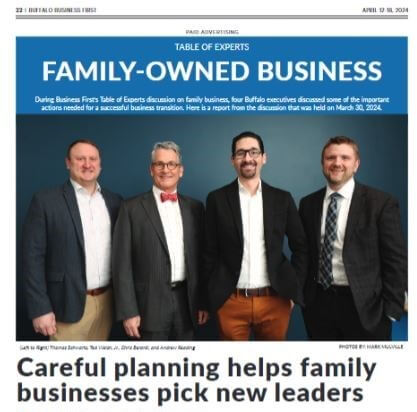As seen in Business First: Andrew Reading discusses the generational shift in WNY Family Owned Businesses
Published April 12, 2024 – Andrew Reading recently participated in a Business First of Buffalo roundtable discussion on the generational shift in leadership in Family Owned Businesses.

Family-owned business: Careful planning helps family businesses pick new leaders
Many small, family-owned businesses, historically the backbone of Western New York’s economy, are approaching a generational shift in leadership as baby boomers arrive at retirement age.
All eyes are on the next-in-line. They have the benefit of past generations’ work to guide them and the privilege of establishing their own approach to operations as they take their companies forward.
Their future success in many ways depends on smart planning for the transfer of ownership years before the new owners are ready to assume leadership. Trusted advisers can be of particular service.
Buffalo Business First Publisher John Tebeau recently gathered small business experts to discuss some of the factors to consider by companies on the brink of a new generation of ownership.

From left: Thomas Schwartz, Ted Walsh, Jr., Chris Berardi and Andrew Reading. Image: MARK MULVILLE
Panelists were:
- Chris Berardi, president, Bengal Machine.
- Andrew Reading, partner, Assurance Services Group, Dopkins & Co. LLP.
- Thomas Schwartz, partner, Chiampou Travis Besaw & Kershner LLP.
- Walsh, Jr., chief executive officer, Walsh Duffield Cos. Inc.
Next generations
While many family-owned companies have a difficult time putting a third generation into leadership, Walsh-Duffield has transitioned into a fifth with Sean Keenan stepping in as president and COO.
It is highly usual, and some oft-quoted statistics bear that out. About a third survive a second generation, 15% make it through the third and 5% through the fourth. Even fewer make it to the fifth.
How has Walsh’s company managed to keep the business in the family since 1860?
“Our strategy has been to see if we can build the organization and provide the opportunity for the next generation,” Walsh said. “Not everyone has that as a priority. Some look at a financial transaction and an exit strategy. Most of our customers do that because that’s what makes the most sense to them. For us we were given the opportunity to grow and build something and the pride to see if there is a group after use to keep that tradition going. We have been fortunate because that is what we originally set out to do.”
His recommendations to other businesses hopeful of continuing ownership through next generations are to involve family in business decisions and develop criteria determining how family members get to join the business.
To earn a position at Walsh-Duffield family members need to work, develop a track record and be promoted at another company and develop skills to bring to Walsh-Duffield.
“We try to raise the bar and make it more complicated and harder for family, so it is not just the family name that gets you the opportunity,” Walsh said. “That has worked best over time to make sure we are disciplined and focused and running a good business.”
Common challenges
Dopkins advisers have a three-point strategy to help business owners identify the direction their company is going:
- Identify how much and which parts of the company to build.
- Protect the company, perhaps through focusing on internal controls or insurance.
- Develop transfer plans, whether that be in part or whole, to an outside buyer or to family.
Decision-making will rise to be the most important aspect of running the business, Reading said. The challenge is to have leaders in the business go through a self-assessment process to determine their strengths, capabilities and skills, and then determine whether the right people are in the right roles to lead the business overall.
“A CPA firm can be extremely helpful beyond year-end taxes and audits,” Reading said. The relationship doesn’t have to be limited to transactions but can extend to helping the clients get a good handle on running the business and understanding financial data and analysis, so they can make good decisions.
Berardi added transparency is critical when discussing individual and company goals.
“A lot of times, you get in a situation where you delay having those conversations until it is potentially too late to be opportunistic at various points in the business, whether it’s holding long-term, transferring to the next generation or exiting something,” Berardi said. “It’s not just being transparent. It’s consistently recommunicating what the individual and business goals are because these things do change. It could range from financial to leadership to managerial to lifestyle goals. In particular, in family businesses that becomes a greater part of the conversation.”
Click here to read the Business First of Buffalo subscriber content.
For more information, contact Andrew J. Reading CPA at areading@dopkins.com.

